Yinqiang Zheng
R3-Avatar: Record and Retrieve Temporal Codebook for Reconstructing Photorealistic Human Avatars
Mar 17, 2025Abstract:We present R3-Avatar, incorporating a temporal codebook, to overcome the inability of human avatars to be both animatable and of high-fidelity rendering quality. Existing video-based reconstruction of 3D human avatars either focuses solely on rendering, lacking animation support, or learns a pose-appearance mapping for animating, which degrades under limited training poses or complex clothing. In this paper, we adopt a "record-retrieve-reconstruct" strategy that ensures high-quality rendering from novel views while mitigating degradation in novel poses. Specifically, disambiguating timestamps record temporal appearance variations in a codebook, ensuring high-fidelity novel-view rendering, while novel poses retrieve corresponding timestamps by matching the most similar training poses for augmented appearance. Our R3-Avatar outperforms cutting-edge video-based human avatar reconstruction, particularly in overcoming visual quality degradation in extreme scenarios with limited training human poses and complex clothing.
Robustifying Fourier Features Embeddings for Implicit Neural Representations
Feb 08, 2025Abstract:Implicit Neural Representations (INRs) employ neural networks to represent continuous functions by mapping coordinates to the corresponding values of the target function, with applications e.g., inverse graphics. However, INRs face a challenge known as spectral bias when dealing with scenes containing varying frequencies. To overcome spectral bias, the most common approach is the Fourier features-based methods such as positional encoding. However, Fourier features-based methods will introduce noise to output, which degrades their performances when applied to downstream tasks. In response, this paper initially hypothesizes that combining multi-layer perceptrons (MLPs) with Fourier feature embeddings mutually enhances their strengths, yet simultaneously introduces limitations inherent in Fourier feature embeddings. By presenting a simple theorem, we validate our hypothesis, which serves as a foundation for the design of our solution. Leveraging these insights, we propose the use of multi-layer perceptrons (MLPs) without additive
Consistent Human Image and Video Generation with Spatially Conditioned Diffusion
Dec 19, 2024



Abstract:Consistent human-centric image and video synthesis aims to generate images or videos with new poses while preserving appearance consistency with a given reference image, which is crucial for low-cost visual content creation. Recent advances based on diffusion models typically rely on separate networks for reference appearance feature extraction and target visual generation, leading to inconsistent domain gaps between references and targets. In this paper, we frame the task as a spatially-conditioned inpainting problem, where the target image is inpainted to maintain appearance consistency with the reference. This approach enables the reference features to guide the generation of pose-compliant targets within a unified denoising network, thereby mitigating domain gaps. Additionally, to better maintain the reference appearance information, we impose a causal feature interaction framework, in which reference features can only query from themselves, while target features can query appearance information from both the reference and the target. To further enhance computational efficiency and flexibility, in practical implementation, we decompose the spatially-conditioned generation process into two stages: reference appearance extraction and conditioned target generation. Both stages share a single denoising network, with interactions restricted to self-attention layers. This proposed method ensures flexible control over the appearance of generated human images and videos. By fine-tuning existing base diffusion models on human video data, our method demonstrates strong generalization to unseen human identities and poses without requiring additional per-instance fine-tuning. Experimental results validate the effectiveness of our approach, showing competitive performance compared to existing methods for consistent human image and video synthesis.
Physics-Based Adversarial Attack on Near-Infrared Human Detector for Nighttime Surveillance Camera Systems
Dec 18, 2024Abstract:Many surveillance cameras switch between daytime and nighttime modes based on illuminance levels. During the day, the camera records ordinary RGB images through an enabled IR-cut filter. At night, the filter is disabled to capture near-infrared (NIR) light emitted from NIR LEDs typically mounted around the lens. While RGB-based AI algorithm vulnerabilities have been widely reported, the vulnerabilities of NIR-based AI have rarely been investigated. In this paper, we identify fundamental vulnerabilities in NIR-based image understanding caused by color and texture loss due to the intrinsic characteristics of clothes' reflectance and cameras' spectral sensitivity in the NIR range. We further show that the nearly co-located configuration of illuminants and cameras in existing surveillance systems facilitates concealing and fully passive attacks in the physical world. Specifically, we demonstrate how retro-reflective and insulation plastic tapes can manipulate the intensity distribution of NIR images. We showcase an attack on the YOLO-based human detector using binary patterns designed in the digital space (via black-box query and searching) and then physically realized using tapes pasted onto clothes. Our attack highlights significant reliability concerns for nighttime surveillance systems, which are intended to enhance security. Codes Available: https://github.com/MyNiuuu/AdvNIR
Instruction-based Image Manipulation by Watching How Things Move
Dec 16, 2024Abstract:This paper introduces a novel dataset construction pipeline that samples pairs of frames from videos and uses multimodal large language models (MLLMs) to generate editing instructions for training instruction-based image manipulation models. Video frames inherently preserve the identity of subjects and scenes, ensuring consistent content preservation during editing. Additionally, video data captures diverse, natural dynamics-such as non-rigid subject motion and complex camera movements-that are difficult to model otherwise, making it an ideal source for scalable dataset construction. Using this approach, we create a new dataset to train InstructMove, a model capable of instruction-based complex manipulations that are difficult to achieve with synthetically generated datasets. Our model demonstrates state-of-the-art performance in tasks such as adjusting subject poses, rearranging elements, and altering camera perspectives.
MotionStone: Decoupled Motion Intensity Modulation with Diffusion Transformer for Image-to-Video Generation
Dec 08, 2024



Abstract:The image-to-video (I2V) generation is conditioned on the static image, which has been enhanced recently by the motion intensity as an additional control signal. These motion-aware models are appealing to generate diverse motion patterns, yet there lacks a reliable motion estimator for training such models on large-scale video set in the wild. Traditional metrics, e.g., SSIM or optical flow, are hard to generalize to arbitrary videos, while, it is very tough for human annotators to label the abstract motion intensity neither. Furthermore, the motion intensity shall reveal both local object motion and global camera movement, which has not been studied before. This paper addresses the challenge with a new motion estimator, capable of measuring the decoupled motion intensities of objects and cameras in video. We leverage the contrastive learning on randomly paired videos and distinguish the video with greater motion intensity. Such a paradigm is friendly for annotation and easy to scale up to achieve stable performance on motion estimation. We then present a new I2V model, named MotionStone, developed with the decoupled motion estimator. Experimental results demonstrate the stability of the proposed motion estimator and the state-of-the-art performance of MotionStone on I2V generation. These advantages warrant the decoupled motion estimator to serve as a general plug-in enhancer for both data processing and video generation training.
SUICA: Learning Super-high Dimensional Sparse Implicit Neural Representations for Spatial Transcriptomics
Dec 02, 2024Abstract:Spatial Transcriptomics (ST) is a method that captures spatial gene expression profiles within histological sections. The discrete spatial distribution and the super-high dimensional sequencing results make ST data challenging to be modeled effectively. In this paper, we manage to model ST in a continuous and compact manner by the proposed tool, SUICA, empowered by the great approximation capability of Implicit Neural Representations (INRs) that can improve both the spatial resolution and the gene expression. Concretely within the proposed SUICA, we incorporate a graph-augmented Autoencoder to effectively model the context information of the unstructured spots and provide informative embeddings that are structure-aware for spatial mapping. We also tackle the extremely skewed distribution in a regression-by-classification fashion and enforce classification-based loss functions for the optimization of SUICA. By extensive experiments of a wide range of common ST platforms, SUICA outperforms both conventional INR variants and SOTA methods for ST super-resolution regarding numerical fidelity, statistical correlation, and bio-conservation. The prediction by SUICA also showcases amplified gene signatures that enriches the bio-conservation of the raw data and benefits subsequent analysis. The code is available at https://github.com/Szym29/SUICA.
Bundle Adjusted Gaussian Avatars Deblurring
Nov 24, 2024Abstract:The development of 3D human avatars from multi-view videos represents a significant yet challenging task in the field. Recent advancements, including 3D Gaussian Splattings (3DGS), have markedly progressed this domain. Nonetheless, existing techniques necessitate the use of high-quality sharp images, which are often impractical to obtain in real-world settings due to variations in human motion speed and intensity. In this study, we attempt to explore deriving sharp intrinsic 3D human Gaussian avatars from blurry video footage in an end-to-end manner. Our approach encompasses a 3D-aware, physics-oriented model of blur formation attributable to human movement, coupled with a 3D human motion model to clarify ambiguities found in motion-induced blurry images. This methodology facilitates the concurrent learning of avatar model parameters and the refinement of sub-frame motion parameters from a coarse initialization. We have established benchmarks for this task through a synthetic dataset derived from existing multi-view captures, alongside a real-captured dataset acquired through a 360-degree synchronous hybrid-exposure camera system. Comprehensive evaluations demonstrate that our model surpasses existing baselines.
Learning to Balance: Diverse Normalization for Cloth-Changing Person Re-Identification
Oct 14, 2024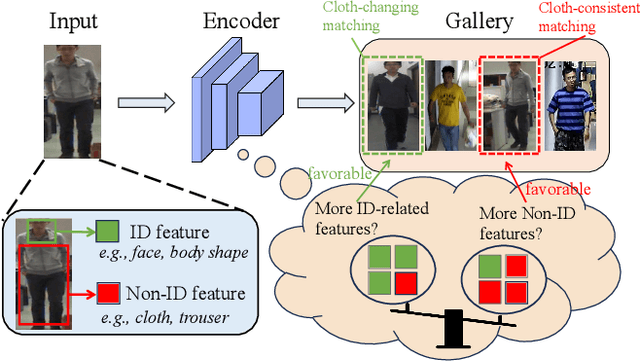

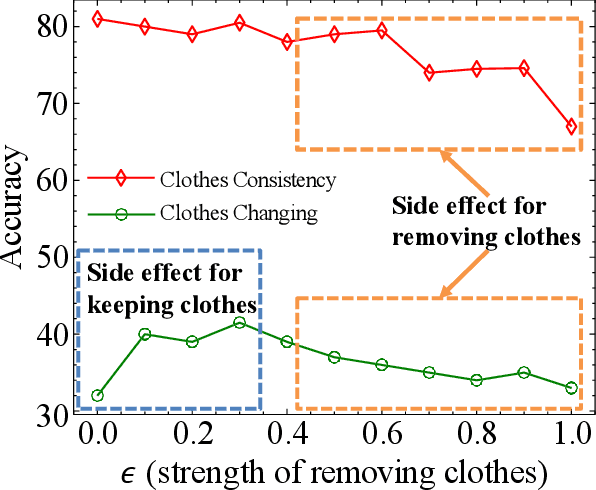

Abstract:Cloth-Changing Person Re-Identification (CC-ReID) involves recognizing individuals in images regardless of clothing status. In this paper, we empirically and experimentally demonstrate that completely eliminating or fully retaining clothing features is detrimental to the task. Existing work, either relying on clothing labels, silhouettes, or other auxiliary data, fundamentally aim to balance the learning of clothing and identity features. However, we practically find that achieving this balance is challenging and nuanced. In this study, we introduce a novel module called Diverse Norm, which expands personal features into orthogonal spaces and employs channel attention to separate clothing and identity features. A sample re-weighting optimization strategy is also introduced to guarantee the opposite optimization direction. Diverse Norm presents a simple yet effective approach that does not require additional data. Furthermore, Diverse Norm can be seamlessly integrated ResNet50 and significantly outperforms the state-of-the-art methods.
ToMiE: Towards Modular Growth in Enhanced SMPL Skeleton for 3D Human with Animatable Garments
Oct 10, 2024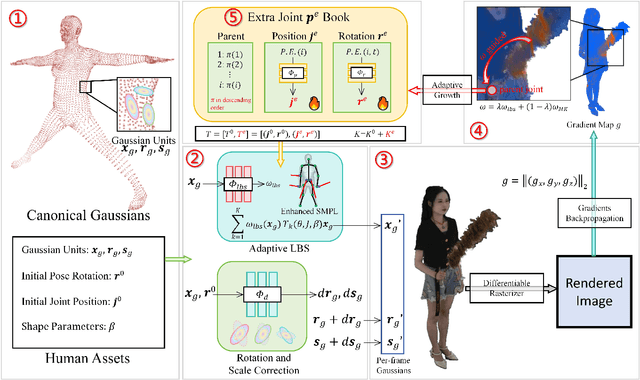

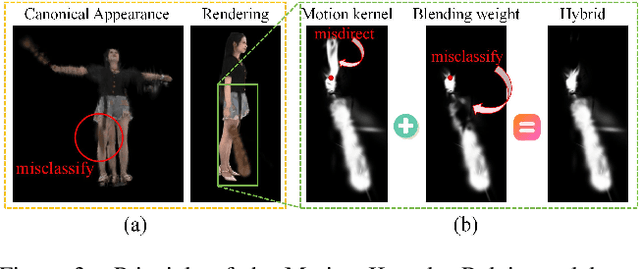
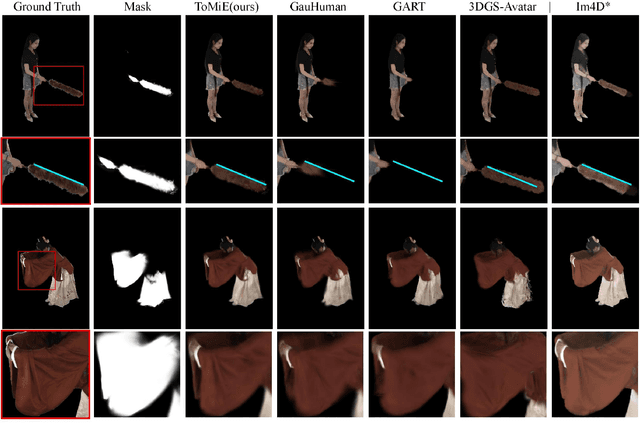
Abstract:In this paper, we highlight a critical yet often overlooked factor in most 3D human tasks, namely modeling humans with complex garments. It is known that the parameterized formulation of SMPL is able to fit human skin; while complex garments, e.g., hand-held objects and loose-fitting garments, are difficult to get modeled within the unified framework, since their movements are usually decoupled with the human body. To enhance the capability of SMPL skeleton in response to this situation, we propose a modular growth strategy that enables the joint tree of the skeleton to expand adaptively. Specifically, our method, called ToMiE, consists of parent joints localization and external joints optimization. For parent joints localization, we employ a gradient-based approach guided by both LBS blending weights and motion kernels. Once the external joints are obtained, we proceed to optimize their transformations in SE(3) across different frames, enabling rendering and explicit animation. ToMiE manages to outperform other methods across various cases with garments, not only in rendering quality but also by offering free animation of grown joints, thereby enhancing the expressive ability of SMPL skeleton for a broader range of applications.
 Add to Chrome
Add to Chrome Add to Firefox
Add to Firefox Add to Edge
Add to Edge